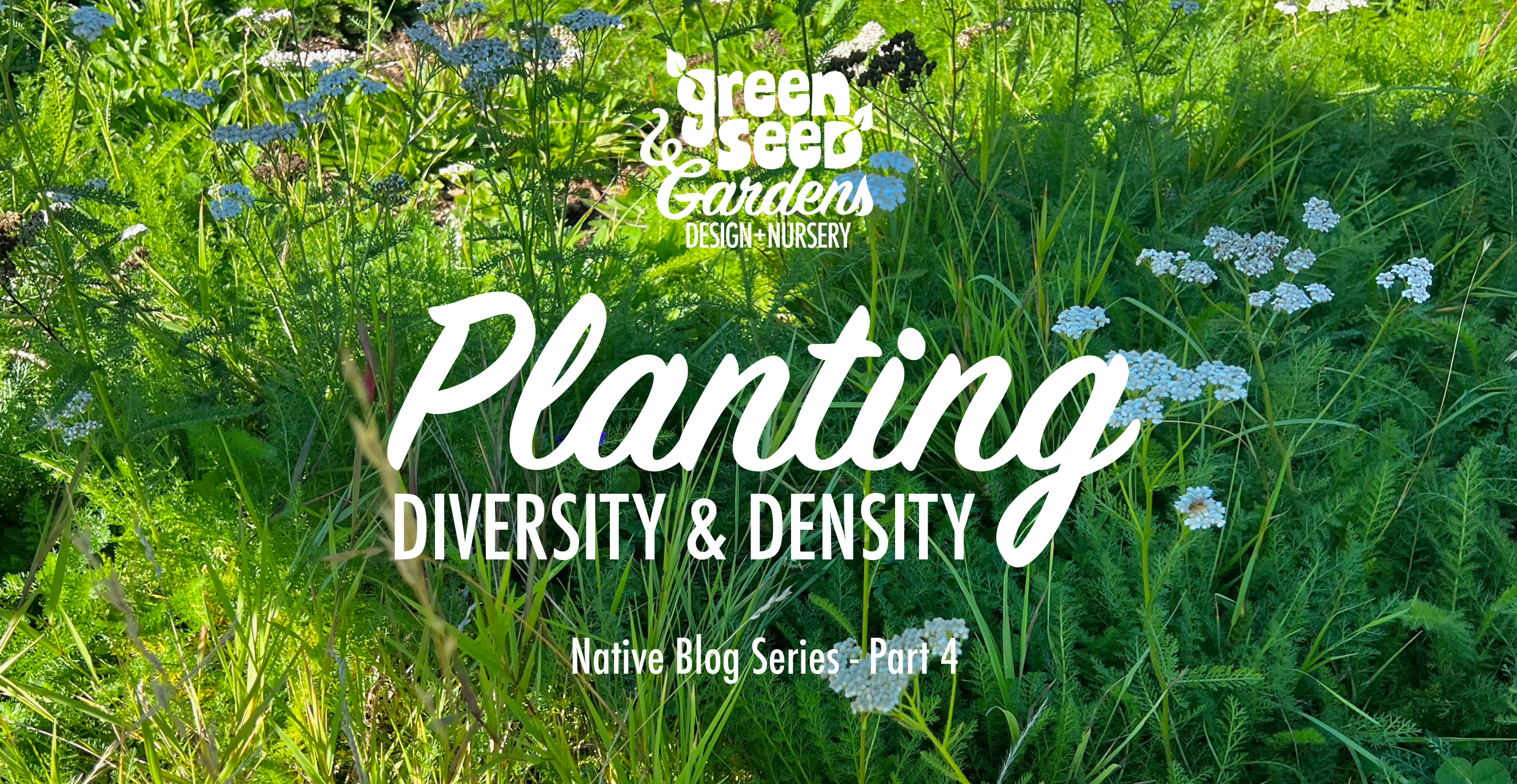
Oregon Native Plants - Part 4: Planting for Diversity and Density
Plant diversity and density play a large role in creating your habitat garden. Let's face it, lawns do have their uses. Looking to play soccer or badminton at your BBQ? Turf grasses are far more wear tolerant than most groundcover alternatives and are often the best solution for those high traffic areas. However, lawns are also resource intensive to maintain and are technically a non-flowering monoculture. For this reason they offer little more ecological benefit than concrete, especially when maintained with gas equipment and pesticides. Overseeding your lawn with an eco-lawn mix that also includes flowering plants can help but only if you designate parts of the lawn where you don’t mow the flowers to the ground every week. We recommend considering how much lawn you really need for your needs and working on replacing any lawn you don’t need (at your own pace) with more biodiverse plantings.



On the other hand, a full garden with many native plantings can support hundreds if not thousands of invertebrate and vertebrate animal species. Planting an array of native plants with diverse flower shapes, colors and bloom times is key to creating a haven for supporting a wide variety of pollinators and other wildlife. Gardens with more diversity of native plants not only contain more species of beneficial insects and wildlife, but also help foster an ecosystem more resilient to pressures like climate change.
We are passionate about natives plants but we do not garden exclusively with them. We recommend being aware of and avoiding invasive species, but also make room for some of your favorite flowers or shrubs for your own enjoyment. Some ornamentals can also benefit pollinators in ways natives can’t because very few natives bloom in Early Spring or Late Fall when certain bumblebees are active. You can also support Anna’s hummingbirds and have flowers through the winter in our climate but you need ornamental shrubs to do it.



Grevillea x 'Leanne' - Leanne Grevillea, Anna's Hummingbird
While we will use some ornamentals for a longer season, they tend to support the more common species of pollinators. Many of the less common and rare pollinators specialize on the flowers of specific types of native plants. If you want to support these pollinators it is crucial to use groupings of many different species of native plants in your landscaping to provide ample nectar for the pollinators that rely on them. It’s also important to consider some keystone plant species, which are plants that play such an important role in our ecosystems that the plants are essential to the existence of many wildlife species.



Spotted Towhee, Native Willow, Spilosoma virginica -Virginia Tiger Moth
Our native Willows (pictured above) are and example of a keystone plant. They provide early nectar to pollinators and are essential host plants for over 300 species of butterfly and moth caterpillars, yet these native species are rarely used in gardens. A large portion of our native songbirds require several thousand caterpillars to raise a nest of chicks successfully and this would not be possible without keystone plant species that support robust numbers of this high protein food source. There is no need to overcomplicate it though, besides considering some keystone species (suggestions below), the most important thing is to mix it up. Plant lots of variety of shapes and colors and make sure you have native plants blooming from Spring to Fall.
Dense groupings of many native plant species create the most productive backyard habitats. Here on the west side things can get wet, plants grow like crazy and all available earth would naturally be colonized by plants without human intervention. Pollinators and wildlife are adapted to and require this density to thrive. We encourage the practice of “cramscaping” to create full gardens with plenty of food and hiding places for wildlife. By mimicking natural conditions you support wildlife more effectively than traditional landscapes of lawn and scattered shrubs that make up the majority of urban and suburban landscapes.



It may sound expensive to fill your space with native plants but it doesn’t have to be, you can work on improving your habitat over time. Many of our native plants have viable seeds which will provide you with lots of free plant starts to fill in open spaces in your garden. Some spreading perennial natives can be divided from existing clumps in a friend's garden or your own. The propagation technique of layering works well for many native shrubs. You pull a stem down to the ground while still attached to the plant and bury a section of the stem with the tip exposed above soil, after it grows roots it can be detached from the plant.
For many varieties of native plants you only need to start with a few of each and you will soon have many of them. Keep in mind open spaces will need to be weeded more frequently while native plants fill in and starting with more plants will reduce the time there is open space. You can also increase both density and diversity on a budget by purchasing native seed which is easier than it sounds and most growers can provide instructions. We also sell many of our plants in smaller sizes and you can get started with more plants and variety this way. Many plants also establish better root systems when planted in the ground while they are small.
Resources:
KEYSTONE SPECIES: for butterflies and moths:
|
Trees |
Shrubs |
Perennials/Groundcover |
Keystone Native Plants - National Wildlife Federation
Plants for bees:
Grindelia integrifolia, Achillea millefolium, Madia elegans, Clinopodium douglasii, Prunella vulgaris var. Lanceolata, Rupertia physodes, Lomatium dissectum, Sidalcea campestris, Allium cernuum, Phacelia nemoralis, Gilia capitata, Eschscholzia californica, Clarkia amoena
Native Plants & Seed:
Green Seed Gardens
SymbiOp
Echo Valley Natives
ProTime Seed